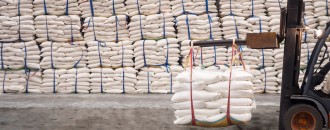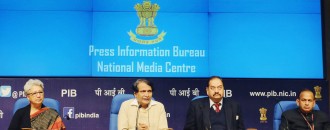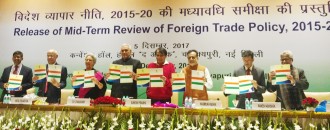
The last FTP scored just ‘pass’ marks. A 40% target-achievement won’t do this time!
Steven Philip Warner | @TheDollarBiz  Policies cannot be judged unequivocally by outcomes. Under such ambiguity, let us say that in many-a-case, failure becomes the twin of a noble impulse, and criticism is the outcome of bold decisions at a macro-level. But there is an indicative measuring rod. A number that has a soul to appraise performance vis-a-vis promise. When FTP 2009-14 was released, the-then policymakers had set a target of crossing the $500 billion mark in India’s exports by FY2014. The target therefore called for $315 billion in incremental annual exports. By FY2012, it had become profoundly certain that India’s FTP lacked punch – perhaps some real big incentives in the form of credit scrips or drawbacks or even interest rate subventions. Our exports that year touched $306 billion, and the utopian expectation of achieving close to $200 billion more in two years seemed unreasonable. During that time, a voice from one of the government chambers claimed thus: “We are well on course to achieve the target to touch the US$500 billion mark by 2014...” Minus the ego trip of making an argument to a favoured audience, the claim was hollow. What ensued from the FTP was that India’s total exports in each of the two years following this statement hardly budged. As compared to a target of $500 billion, our exports just about managed to vault past the $313 billion level. Conclusion: Instead of a $315 billion jump that was promised, India’s annual export saw an annual addition of only $128 billion or about 40.75% of the desired increase. Going by what we’ve traditionally been taught in school, that meant a pass percentage. But that isn’t enough. What we expect from the new FTP is simple: some bold moves. There are many issues that can be addressed by the new FTP – the strange co-existence of Advance Authorisation and Duty Free Import Authorisation scheme (in the absence of transferability of duty credit scrips), non-accountability of individual States (a five year State-level export policy should be made mandatory), question over the continuation of interest rate subvention schemes (playfully extending such schemes year-on-year isn’t a healthy idea), ineligibility of Service Exports from Focus Market Scheme or FMS (Service exports of India brought in $153 billion in forex earnings in 2013; why should we put one sector at a disadvantage to give advantage to another – and what’ the methodology of choosing “select” names in this category?), high transaction costs for exporters (just implementing e-payment systems will not help)...and many more. Real incentives will mean spiritual joy for the exporter community. An exports target of $500 billion in five years (that we missed in 2009-14) could either be a proof of the difficulty of forecasting, or that there is much change that can be incorporated in the new FTP. Whatever that can be done should be done to ensure that the next time we compare the elephant and the dragon in global trade, we get more respect. Forget China, we are behind countries like Mexico and Belgium in exports! An ambitious target isn’t the issue. It’s the policy that has to trigger the onward march beyond borders. A bold, redrafted FTP that can achieve more than just passing percentage when reviewed five years later is what India needs. And that’s not an illogical ask. Or is it?
Policies cannot be judged unequivocally by outcomes. Under such ambiguity, let us say that in many-a-case, failure becomes the twin of a noble impulse, and criticism is the outcome of bold decisions at a macro-level. But there is an indicative measuring rod. A number that has a soul to appraise performance vis-a-vis promise. When FTP 2009-14 was released, the-then policymakers had set a target of crossing the $500 billion mark in India’s exports by FY2014. The target therefore called for $315 billion in incremental annual exports. By FY2012, it had become profoundly certain that India’s FTP lacked punch – perhaps some real big incentives in the form of credit scrips or drawbacks or even interest rate subventions. Our exports that year touched $306 billion, and the utopian expectation of achieving close to $200 billion more in two years seemed unreasonable. During that time, a voice from one of the government chambers claimed thus: “We are well on course to achieve the target to touch the US$500 billion mark by 2014...” Minus the ego trip of making an argument to a favoured audience, the claim was hollow. What ensued from the FTP was that India’s total exports in each of the two years following this statement hardly budged. As compared to a target of $500 billion, our exports just about managed to vault past the $313 billion level. Conclusion: Instead of a $315 billion jump that was promised, India’s annual export saw an annual addition of only $128 billion or about 40.75% of the desired increase. Going by what we’ve traditionally been taught in school, that meant a pass percentage. But that isn’t enough. What we expect from the new FTP is simple: some bold moves. There are many issues that can be addressed by the new FTP – the strange co-existence of Advance Authorisation and Duty Free Import Authorisation scheme (in the absence of transferability of duty credit scrips), non-accountability of individual States (a five year State-level export policy should be made mandatory), question over the continuation of interest rate subvention schemes (playfully extending such schemes year-on-year isn’t a healthy idea), ineligibility of Service Exports from Focus Market Scheme or FMS (Service exports of India brought in $153 billion in forex earnings in 2013; why should we put one sector at a disadvantage to give advantage to another – and what’ the methodology of choosing “select” names in this category?), high transaction costs for exporters (just implementing e-payment systems will not help)...and many more. Real incentives will mean spiritual joy for the exporter community. An exports target of $500 billion in five years (that we missed in 2009-14) could either be a proof of the difficulty of forecasting, or that there is much change that can be incorporated in the new FTP. Whatever that can be done should be done to ensure that the next time we compare the elephant and the dragon in global trade, we get more respect. Forget China, we are behind countries like Mexico and Belgium in exports! An ambitious target isn’t the issue. It’s the policy that has to trigger the onward march beyond borders. A bold, redrafted FTP that can achieve more than just passing percentage when reviewed five years later is what India needs. And that’s not an illogical ask. Or is it?





 to success.
to success.